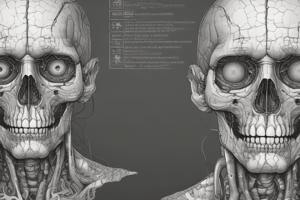Podcast
Questions and Answers
Where do the conductors of deep sensitivity pass in the spinal cord?
Where do the conductors of deep sensitivity pass in the spinal cord?
- Anterior horns
- Rear horns
- Posterior cords (correct)
- Lateral cords
Which artery of the Circle of Willis connects the system of carotid and vertebral arteries?
Which artery of the Circle of Willis connects the system of carotid and vertebral arteries?
- Anterior communicating artery
- Ophthalmic artery
- Posterior communicating artery (correct)
- Anterior cerebral artery
In what part of the inner capsule do the sensing conductors pass?
In what part of the inner capsule do the sensing conductors pass?
- Posterior 1/3 of anterior horn (correct)
- Anterior 2/3 of anterior horn
- Knee
- Posterior 1/3 of the posterior thigh
Where is the VI cranial nerve located?
Where is the VI cranial nerve located?
Which nerve is involved in the formation of the plantar reflex?
Which nerve is involved in the formation of the plantar reflex?
What part of the inner capsule is for the conductors of general sensitivity?
What part of the inner capsule is for the conductors of general sensitivity?
Where is the third neuron of the deep sensation pathway located?
Where is the third neuron of the deep sensation pathway located?
Which of the following is NOT a type of deep sensitivity?
Which of the following is NOT a type of deep sensitivity?
A lesion causing the sensation of 'gloves on arms and socks on legs' is likely due to damage to:
A lesion causing the sensation of 'gloves on arms and socks on legs' is likely due to damage to:
The third neuron of the superficial sensation pathway is located in which of the following structures?
The third neuron of the superficial sensation pathway is located in which of the following structures?
Which of the following is a sign of lesion in the left parietal lobe?
Which of the following is a sign of lesion in the left parietal lobe?
The sensation of 'creeping crawling' without external irritation is known as:
The sensation of 'creeping crawling' without external irritation is known as:
Which of the following is characteristic of a lesion affecting the posterior horns of the spinal cord?
Which of the following is characteristic of a lesion affecting the posterior horns of the spinal cord?
In the Brown-Sequard syndrome, which of the following is NOT present?
In the Brown-Sequard syndrome, which of the following is NOT present?
Which of the following is a characteristic feature of a lesion affecting the upper cervical part of the spinal cord?
Which of the following is a characteristic feature of a lesion affecting the upper cervical part of the spinal cord?
In the Klumpke-Déjerine-Tinel syndrome, at which level of the spinal cord are the affected segments located?
In the Klumpke-Déjerine-Tinel syndrome, at which level of the spinal cord are the affected segments located?
In a lesion affecting the half-transverse section of the spinal cord at the thoracic level, which of the following is NOT expected?
In a lesion affecting the half-transverse section of the spinal cord at the thoracic level, which of the following is NOT expected?
Which of the following is a characteristic feature of a lesion affecting the lumbar thickening of the spinal cord?
Which of the following is a characteristic feature of a lesion affecting the lumbar thickening of the spinal cord?
Flashcards are hidden until you start studying
Study Notes
Nerve Involvement
- The pharyngeal nerve is involved in the formation of the pharyngeal reflex.
- The plantar reflex is formed by the tibial nerve.
- The VII cranial nerve is located in the pons.
- The VIII cranial nerve is located in the pons.
- Posterior communicating artery connects the carotid and vertebral artery systems.
Sensitivity and Reflexes
- Deep sensitivity conductors pass through the posterior cords.
- General sensitivity conductors pass through the posterior third of the posterior thigh.
- VI cranial nerve is involved in the formation of the plantar reflex.
Brain and Spinal Cord
- Gaulle and Burdach bundles are involved in posterior columnar ataxia, Brown-Séquard syndrome, paraanesthesia, and hyperpathy.
- Posterior horns of the spinal cord are involved in conductive type deep sensitivity disorders.
- Lesion of the left parietal lobe can result in astereognosis of the left hand.
- Lesion of the right parietal lobe can result in astereognosis of the left hand.
Agnosia and Aphasia
- Types of agnosia include visual, auditory, olfactory, and flavoring.
- Motor agnosia is not a type of agnosia.
- Signs of left parietal lobe lesion include agraphia, apraxia, and alexia.
- Signs of right frontal lobe lesion include acalculia and motor aphasia.
Clinical Signs
- Asteriognosis of the left hand is a sign of lesion of the right parietal lobe.
- Mutism is a sign of violation of the parietal lobe on the left.
- Amusia is a sign of violation of the parietal lobe on the left.
- Hemianopsia is a sign of violation of the frontal lobe on the right.
Syndromes
- Syndrome of Klodt-Bernard-Gorner appears when segments of the spinal cord are affected at the level of C6-TH1.
- Syndrome of Brown-Séquard is characterized by spastic paraparesis of lower limbs, conductive type of sensitivity disorders, and dysfunctions of pelvic organs.
- With the defeat of the lumbar thickening, there are central paresis of lower limbs, segmental dissociated type sensitivity disorders, and violation of function of pelvic organs.
- With the defeat of the upper cervical part of the spinal cord, there is spastic tetraplegia.
- With the defeat of half transversal of the spinal cord at the thoracic level, there is decreased joint sense of the right lower limb and decreased pain sensitivity on the right lower limb.
Studying That Suits You
Use AI to generate personalized quizzes and flashcards to suit your learning preferences.




